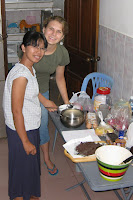
This was formerly a high school, but since the goal was to do away with all forms of education, it was transformed to a prison and place of torture. Over 20,000 people were interrogated in order to try to get them to name friends and family who would then in turn also be tortured and ultimately killed.

Look at the floor in the picture above. What's horrific is that you can still see dried blood along the walls or puddled on the floor in these rooms where the torture took place. Yet another reminder that this is recent history...

While visiting, we met this man, Chum Mey, who was one of 7 survivors of Tuol Sleng. (he's on the far left of the other 6 in this picture he is standing beside) He described the horror of seeing his wife and son murdered and the torture of having his head pounded, toenails twisted and ripped off, sticks jammed in his ears, fingers broken, and the other gruesome things that were done to him. He was kept alive because of his high mechanical skills and now frequently visits the genocide museum to share his story.
We also had the opportunity to go to Choeung Ek. While most of the country could have been considered "the killing fields," this area was notorious for the deaths which occurred here and has now been made into a memorial museum. After torturing the people at Tuol Sleng, they were sent here to be executed.


This monument was constructed for remembrance and is filled with 17 tiers of skulls, bones, and clothing from the victims.

In an attempt to save on costly bullets, people were murdered in whatever way was most convenient-- beaten against a tree, a blow from a shovel or ax, etc. Then chemicals were poured over the bodies to reduce the stench and to be sure that no one was left alive. 126 mass graves have been uncovered here...
This happened just 30 years ago. The survivors are alive to tell their stories. The country is still recovering from the aftermath--both physically and in its government and education systems. Refugees are still relocated. And yet we are seldom taught about the Khmer Rouge in schools or hear about it on the news even though there is still so much happening with regard to it.
In fact the trials are still going on. Just Monday BBC released THIS article on "Duch," the leader of the interrogations at Tuol Sleng. He was finally tried in July (though we heard very little about it while it was happening) and sentenced to not life, but 35 years in prison-- since then, it has been shortened to 19 years. What shocks me is that trials did not actually begin get under way and become fully operational until 2007 and that Duch is the first to receive any sentence.
Sorry for being so wordy and full of gruesome detail, but this is history and reality and something I think we should, at the very least, be aware of

















